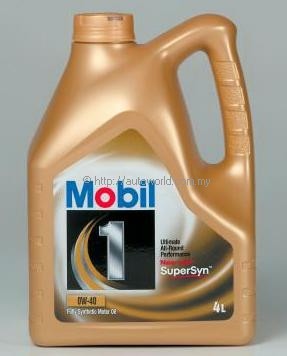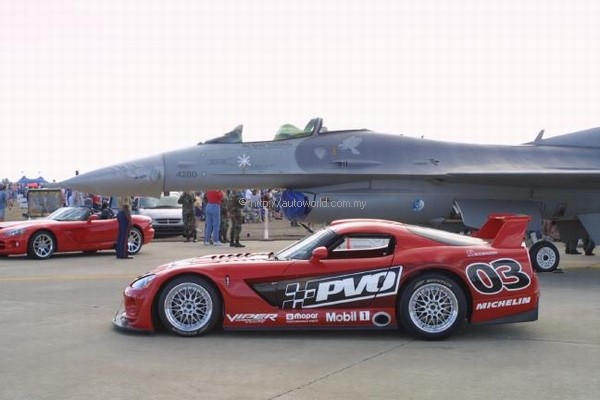New Mobil 1 with SuperSyn
Mobil 1, the product that has been most synonymous with synthetic oil for automobiles, has gone into a fifth generation. The new product, which comes 30 years after the first introduction of Mobil’s high-performance lubricant (initially known as Mobil SHC), is claimed to be the best motor oil ExxonMobil engineers have ever developed.
Although Mobil 1 has always been able to meet the tougher requirements of automobile manufacturers – often exceeding those requirements substantially – changing consumer demands and government regulations (especially in the USA) have resulted in ever higher specifications for oil performance. This has led ExxonMobil to come up with the latest formulation which has SuperSyn, a proprietary anti-wear technology which is said to offer outstanding wear protection, enhanced performance at all temperature extremes, even better engine cleanliness and enhanced fuel economy benefits.
Development of SuperSyn technology originated in Formula 1 racing and has also proven itself in drag racing. In such highly intense and extreme operating conditions, Mobil lubricants with the technology have provided superior protection to bearings and other components, enabling engines to function reliably from start to finish.
As before, the new Mobil 1 not just meets the toughest standards around the world but also exceeds them, the nature of its formulation being such that its upper limits are ‘stratospheric’ in comparison to most other oils. Not surprisingly, it has also been used beyond the stratosphere in spacecraft for many years.
As requirements vary from country to country and due to the variety of vehicles with different types of engines, Mobil 1 is available in a number of viscosities, the more popular being SAE 0W/40 and 5W/50. It is also the oil which is used as the first-fill by companies such as Mercedes-Benz AMG, Porsche, Aston Martin, Chevrolet, Cadillac and Chrysler for their high performance and luxury models.
And of course, many top racing teams, including those in F1, use engine oils which are technologically similar to Mobil 1 but with some elements modified due to the extreme nature of their usage where engines like the one in the McLaren Mercedes can generate 800 bhp and spin up to 17,500 rpm.
The fact that is it put into brand new engines – especially such high-performance, expensive and sophisticated ones – should end the debate on whether you can use a synthetic oil in new engines. The thinking in the past was that you should not, because synthetic oil is so slippery that it will inhibit the running-in process where parts wear out a bit to interface properly with each other.
In ExxonMobil’s explanation on this issue, the practice of using conventional mineral-based oils is considered no longer valid due to modern manufacturing processes. In the past, running-in an engine for anywhere between 5,000 kms and 10,000 kms was necessary not only to enable some wear to occur but also to allow the valves and piston rings to seat properly. However, in today’s engines, the tolerances are much tighter with much better machining and cleaner conditions compared to the processes used 10 or 20 years ago.
Thus the process of running-in is no longer important (although you should drive sensibly in the first thousand kilometers) and this too has been confirmed by the chief engineer of the Honda City, who told AUTOWORLD.COM.MY the same thing. In fact, he went as far as to say that an owner could enjoy the full performance of the engine right away.
Also on a similar issue, he said that the usual requirement to change the oil in the first 500 or 1000 kms because it would be polluted with metal bits and dirt was no longer the case, so owners could just follow the normal 5000 km interval that Honda specifies. That’s comforting if you have an expensive oil like Mobil 1 in the sump!
The new Mobil 1 has more ‘performance reserve’ to cater for the trend towards longer oil change intervals being applied by a number of manufacturers, notably those in Europe and North America. This means that its performance and qualities will not be diminished over a longer period and indeed, Mobil 1 can actually be used for much longer than the even the longest intervals recommended today.
Back in the early days of Mobil 1, the company even indicated on its packaging that the oil could be used for as long as 44,000 miles or something like that but by the early 1990s, this particular statement had disappeared. While there was still highlighting of the oil’s extended service life – one example being its ability to keep an engine run for 1.6 million kms as good as new – Mobil (ExxonMobil only came into being in recent times with the merger of the companies) did not want to take on the liability for any possible damage to engines if owners kept their oil inside for longer than what the engine manufacturers themselves were recommending.
“Basically, the engine manufacturers told us not to ‘mess around’ with the issue by suggesting that people could ignore the intervals set by them and not change the oil for a longer period,” said one Mobil engineer back in 1995 when this writer asked the question.
So from then on, the official response has been that the motorist should follow whatever the vehicle manufacturer recommends and if it is 5000 kms (which is still the norm for many Japanese makes), then that is the interval to use. If this adhered to, then warranties of virtually all vehicles should not be invalidated provided the owner also observes all the other conditions for the warranty.
In Malaysia, though, it seems that there may be a warranty issue with Perodua concerning the use of lubricants other than their in-house brand so it is a good idea to enquire for this particular make. Also, as synthetic oil is not supposed to be used with rotary engines, the warranty on Mazda cars with such engines will be invalidated if this kind of oil is used.
Considering the price of Mobil 1, it may therefore need some justification to use it if you have to change it every three months or so. Of course, ExxonMobil will tell you that if you love your car and want to give it the best, then cost should not be an issue!
So it is up to the owner to make a decision and it’s best to wait for the warranty to finish (which takes longer these days) if there is any intention to extend the oil change interval beyond what is recommended. While company policy dictates that they cannot offer any specific recommendation to motorists, ExxonMobil engineers will often speak of their own experiences where they have confidence to change the oil once a year when using Mobil 1. They suggest that if anyone decides to go for an interval of 10,000 kms or more, then it is advisable to at least change the oil filter sometime after 5000 kms. This is because the superior cleaning qualities of the additives will bring a lot of dirt and sludge into the oil and a filter can only contain so much of these contaminants. If not changed for too long, the accumulation of such undesirable stuff could affect the oil pressure or flow and damage the engine. You can change the oil filter without losing all the oil as there is a one-way valve for safety reasons.
Mobil 1 can also be used with older engines but it is better to use one with a thicker viscosity because older engines with high mileage may be more worn out and tolerances may be greater. However, the good thing about some of the additives in Mobil 1 is that they will clean out the engine and help clear stuck rings, thereby restoring engine efficiency. Of course, if the engine is too worn out or has some other problems, Mobil 1 isn’t going to make it run any better!
We understand that Mobil 1 with SuperSyn is now available at Esso and Mobil stations but as the press kit provided did not contain any information on local pricing, we can’t tell you how much the new product costs. It is believed that it does cost more than the old formulation and you can get it in 4-litre and 1-litre packs.




























